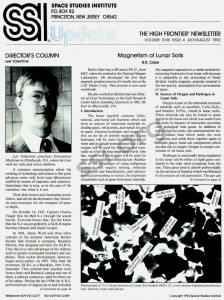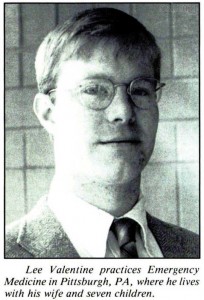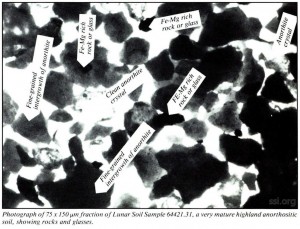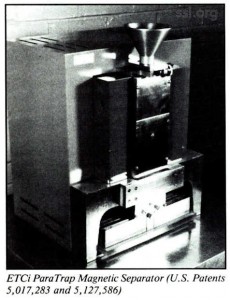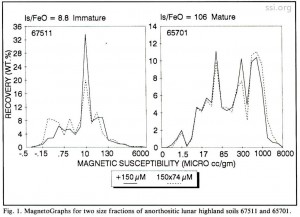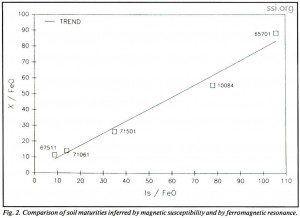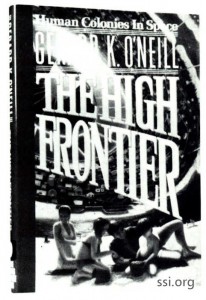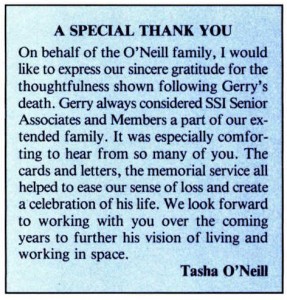SPACE STUDIES INSTITUTE
P.O. BOX 82
PRINCETON, NEW JERSEY 08542
[[librarian note: This address is here, as it was in the original printed newsletter, for historical reasons. It is no longer the physical address of SSI. For contributions, please see this page]]
SSI UPDATE
THE HIGH FRONTIER® NEWSLETTER
VOLUME XVIII ISSUE 4 JULY/AUGUST 1992
DIRECTOR’s COLUMN
Lee Valentine
A common misconception about the working of technology and science is that great advances come only from large laboratories staffed by armies of engineers and scientists. Sometimes that is true, as in the case of the transistor, but often it is not.
Three little known and fascinating stories follow, and all the developments they chronicle were necessary for the conquest of space to begin.
On October 14, 1947, Captain Charles Yeager flew the Bell X-1 through the sound barrier. Everyone knows that, but few know that the X-1 was propelled by a XLR-II engine burning ethanol and liquid oxygen.
In 1941, James Wyld and three other veterans of the amateur American Rocket Society had formed a company, Reaction Motors, that designed and built the XLR-II. They did so to take advantage of the military need to launch overloaded bombers and seaplanes. Their rocket development, however, began much earlier – in 1935. They built the prototype, XLR-I, in a Brooklyn, New York, basement. They ordered their machine tools from a Sears and Roebuck catalog and one of them, a subway conductor, paid for them out of his salary. During the late 1930s the A.R.S. performed tests of engines up to and including the XLR-I near Stockton, NJ. A cluster of four XLR-Is formed the XLR-II. A cluster of four XLR-IIs powered the MX-774, a secret multi-ton long-range rocket. The MX-774 was the first to to demonstrate two crucial innovations: balloon tanks, which greatly reduce the weight of the tank structure, and thrust vector control by gimballed motors. The MX-774 team eventually produced the Atlas rocket using lessons learned from that program. John Glenn rode an Atlas into orbit in February, 1962.
The second story begins in 1934. It is even less well known than the achievements of James Wyld and the American Rocket Society and does not concern the requisite rocket muscle of space flight, but rather the necessary computational brains. Leading directly to milestones in computer science, the development of programmable controlled computers began in 1935, independently in Germany and the United States. In America, several large, well-financed teams at Harvard, Bell Labs, and at the University of Pennsylvania took the initiative.
But our story begins in the Berlin living room of the parents of Konrad Zuse. Zuse, an engineer, sought to automate the “awful calculations” required in his profession. He built his first machine, all mechanical, of meccano parts in his parents’ living room. His second machine used electromechanical relays but was not fully programmable. Zuse completed the first fully functional program controlled computer, the Z3, in late 1941. Zuse and his programmer, a blind mathematician named August Fast, also developed Plankalkul, the first high-level programming language. It is only fair to say that the Z3 was partly financed by D.V.L., the German Society for Aeronautical Research.
Three years later, in 1944, the Harvard team finished the first fully programmable computer to be built in the United States.
Zuse summed up the situation in 1945 in this table:
| Germany | U.S.A. |
|---|---|
| binary system | decimal system |
| floating point | fixed point |
| electromechanical machines | electromechanical |
| initial electronic attempts magnetic storage |
electronic machines |
| small expenditure | great expenditure |
The third story tells of the beginning of the modern aluminum industry. The potential of aluminum to transform industry was well known by the 1880s, thanks to the pioneering work of Sainte-Claire DeVille in France. Aluminum was as expensive per pound then as spaceflight per pound is now. When he learned of these possibilities as a student at Oberlin, Charles Martin Hall was determined to change those economics. He first tried, with the able assistance of his older sister, Julia, to reduce aluminum oxide by purely chemical means. Then Hall and his professor, Frank F. Jewett, investigated electrolysis of aqueous aluminum salts during his senior year.
After graduation, Half moved his experiments to his parents’ woodshed, and he began to experiment with aluminum oxide dissolved in molten salt. Over the next eight months he built a higher temperature furnace, a simple gas burner inside an iron pipe lined with clay. He then developed a mixture of sodium and aluminum fluoride that had a melting point within the capability of his furnace and that would dissolve copious quantities of aluminum oxide. Still working in the woodshed, he succeeded in producing shiny nuggets of pure aluminum metal on February 23, 1886. Today they are on display at Alcoa headquarters in Pittsburgh.
Seventeen years later, the Wright brothers cast the engine block for their flyer from Alcoa aluminum. Just over forty years later, a long, thin aluminum contraption rose into the air in Woburn, Massachusetts – the world’s first liquid fueled rocket.
What can we conclude from these brief stories? Well, we can’t say that if these had never happened that the world would be utterly different. Harvard, after all, produced a machine only three years after Zuse, and Herroult applied for a French patent on the electrolytic reduction of aluminum only two months after Hall demonstrated it in his workshed, but Wyld, Zuse, and Hall were the technological leaders of their day. They had leads of months to years, and they had all been brought to a high state of technological readiness by meager private means.
This same philosophy forms the basis of SSI’s research projects. The Space Studies Institute continues to carry out its critical technology developments with small groups intensely focused and able to work uninterrupted on a problem until a solution is in hand. As you know, many technical problems remain to be solved before we settle even the nearest shore of the high frontier. Because of the existence of the Space Studies Institute, I am confident that we will have solutions in hand when the time comes to apply them. I am equally sure that they will have been developed by small groups of talented individuals, because many of them are already working under our aegis.
Magnetism of Lunar Soils
R.R. Oder
Robin Oder has a BS and a Ph.D. from MIT, where he worked at the National Magnet Laboratory. He developed the first high magnetic gradient process for kaolin clay at the J.M. Huber Corp. That process is now used worldwide.
He also worked at Bechtel and was Director of Coal Technology at the Gulf Research Center before founding Exportech in 1982. He lives in Murrysville, PA.
I. Introduction
The lunar regolith contains lithic, mineral, and fused soil fractions which can serve as sources of important materials including gases, refractories, and metals for use in space. Gaseous hydrogen and oxygen are first on the list of priority materials. Lunar hydrogen will be used for manufacture of water and as a local reconnaissance fuel. Lunar oxygen will be used for breathing and eventually as a fuel for long range space travel. One day, metals and refractories will be used for space construction and manufacture. Realization of the advantages of using indigenous resources will require mining, minerals preparation and beneficiation, and physicochemical processing to extract the important components such as gases from lunar materials.
Dry magnetic separation is a viable method for extracting feedstocks from lunar soils because it is adaptable to dry processing of finely divided, weakly magnetic, granular material in the low-gravity, atmosphere-free environment of space.
II. Sources of Oxygen and Hydrogen in Lunar Soils
Oxygen is part of the elemental structure of minerals such as anorthite, CaAl2Si208, and ilmenite, FeTio3, found in lunar rocks. These minerals can also be found to some degree in the lunar soil which was made from the rocks by impacts of meteorites occurring over geological time spans. In addition to pulverizing the rocks, the micrometeorite impacts release heat which melts the rock fragments and welds them together again in complex glassy fused soil components which are also rich in oxygen. Oxygen is a major constituent of all lunar soils.
Hydrogen is continually being implanted in the lunar soil by influx of light gases contained in the solar wind streaming from the sun. These gases tend to adsorb preferentially on the surfaces of ilmenite which was liberated in the process of soil generation. The gas can be released by heating. Indeed, the adsorbed hydrogen has played a role in creation of metallic “native” iron also found in the lunar soil. Driven by the heat of impact, the hydrogen reduces meteoric iron oxides to produce microcrystalline iron, Fe°, which is found in strongly magnetic vesicular glass components called agglutinates. They are unique to the surface of the Moon. Hydrogen is a minor constituent of lunar soils.
Long periods of exposure to the solar wind and to impacts by micrometeorites create mature soils which are fine in size and which concentrate gases such as hydrogen. At this time it is believed that extraction of hydrogen and oxygen from the soil rather than from rocks will prove to be more practical because heavy machinery for crushing and grinding operations will not be required to liberate the rock components.
III. Magnetic Separation of Lunar Soil Samples
Most lunar rocks are diamagnetic in nature. Paramagnetism is generally associated with Fe2$ found in minerals such as ilmenite FeTiO3 and pyroxene (Ca, Mg, Fe) SiO3. The specific susceptibilities of these minerals generally range up to 100 µcc/gm. Fe3$ is nonexistent on the moon so magnetite is not present. The lunar rocks we have investigated are generally less magnetic than are the soils sampled from the same area. The strong magnetism of lunar soils is associated with single-domain sized metallic iron (Fe°, native iron) found in the vesicular glassy agglutinates, splash glasses, melt rocks, and other fused soil product of the energetic micrometeorite impacts.
In recent laboratory work, diamagnetic anorthite, x = -0.39 µcc/gm, paramagnetic ilmenite, χ ≅ 60 µcc/gm, and ferromagnetic glass-encased metallic iron, apparent susceptibility χa > 130 µcc/gm, have been separated [ ].
This work, however, has shown that processing lunar soils will not be without its own problems. While exposure to the solar wind implants hydrogen in the soil, simultaneously, this exposure also brings micrometeorite impacts which destroy the identity and separability of individual soil components such as ilmenite. Soil components which have lost their identities will not be good candidates for separation by any method. A compromise will be required between choosing mature soils for production of hydrogen on the one hand and choosing less mature soils for production of oxygen on the other. Assessments of both chemistry and soil maturity will be vitally important in the first robotic missions to prospect the lunar surface.
IV. Effects of Lunar Soil Maturity
Magnetic separation of lunar soil is strongly affected by the maturity of the soil. Our work has shown that the distribution by weight of the lunar soil recovered in different magnetic susceptibility intervals is significantly affected by soil maturity. This is illustrated in the MagnetoGraphs of Figure 1 for two size fractions of anorthositic highland soils of widely differing maturities. The maturity of a soil is measured scientifically by the ratio of singledomain iron concentration, IS (as determined by Ferromagnetic Resonance (FMR) divided by the ferrous iron oxide composition, FeO,-IS/FeO. The higher the value of the ratio, the greater the maturity. The highland soils have IS/FeO values of 8.8 and 106 respectively. The MagnetoGraphs show the percentage of the total sample weight which is recovered in the magnetic susceptibility intervals in which the separations were made.
Because the breadth of the distribution shown in Figure 1 increases with maturity, the amount of material separated in the low susceptibility interval, nominally
As a general rule, soils of lowest maturity are the best candidates for magnetic separation for lithic and mineral soil fractions ranging from diamagnetic alumino-silicates to paramagnetic iron oxides such as ilmenite or pyroxene. Soils of high maturity, however, are the best candidates for separation of strongly magnetic fused soil components which are the best sources for production of hydrogen and metallic iron.
V. Magnetic Susceptibility and Soil Maturity
Soil maturity and magnetism are synonymous. The more mature soils are more magnetic and magnetic susceptibility is a convenient measure of the maturity of the soil. Our measurement of soil maturity, as given by the ratio of magnetic susceptibility to ferrous iron content, is plotted vs. the maturity parameter in Figure 2. The values for the maturity parameter, IS/FeO, have been taken from the Handbook of Lunar Soils (Morris, et al., 1983). Magnetic susceptibility and FeO are each directly measured. No chemical, image analysis, or magnetic interpretations are employed. The excellent correlation between the susceptibility and conventional maturity parameters confirms that the magnetic susceptibility is a good indicator of soil maturity. The significance of this observation lies in the simplicity and effectiveness of measurement of the magnetic susceptibility compared to measurements of FMR.
NASA’s newly re-established Office of Exploration is planning several small, robotic missions to the Moon within the next three years to begin the Space Exploration Initiative, the nation’s program to return to the Moon and journey to Mars. Some of these missions will be directed at acquiring knowledge about the distribution of lunar resources and the detailed characteristics of the surface at proposed human outpost sites. These goals move resource assessment to the forefront. As part of this strategy, NASA’s Artemis program to design a common lunar lander offers an opportunity for deployment of innovative, simple, and feasible instrumentation packages for assessing the potential for processing lunar soils.
Before the surveillance missions begin, there is a need to test the response of lunar soils to a variety of beneficiation techniques, such as has been done with magnetic separation. NASA’s existing library of lunar samples brought back during the earlier Apollo missions and administered by LAPST should be opened and used for this test work. This will give us a base of knowledge with which to judge the viability of proposed future human outpost sites on the moon. We must also begin to develop practical instrumentation for use in the robotic prospecting missions of the next few years. NASA’s planning calls for a series of missions of both orbital and landed payloads. The surface rover missions will be designed for surveying the lunar surface for identification of sites for future outposts and for testing of innovative process packages which meet the criteria for simplicity and feasibility.
We believe that magnetic susceptibility should be incorporated into the first rover instrumentation packages to identify candidate soils for resource utilization. Techniques such as Mossbauer spectroscopy have been proposed because the method is sensitive to iron oxidation states.
Ultimately this information will be very important, but the cost of obtaining it now at this early stage of exploration may be prohibitive. For the first attempt, the goals of simplicity and feasibility suggest that magnetic susceptibility is a better choice. In addition, the rate at which information on the magnetism, and hence the maturity, of lunar soils can be returned to Earth is more than two orders of magnitude greater for susceptibility measurements than for gamma-ray spectrometric methods. That could prove to be vitally important for these first exploratory missions!
SUGGESTED READING
R.R. Oder and L.A. Taylor, “Magnetic Beneficiation of Highland and HI-Ti Mare Soils: Magnet Requirements,” Engineering, Construction and Operations in Space II, Proceedings of Space 90, Albuquerque (April, 1990), Edited by S.W. Johnson and J.P. Wetzel (American Society of Civil Engineers, New York, 1990) pp. 133-142.
L.A. Taylor and R.R. Oder, “Magnetic Beneficiation of Highland and HI-Ti Mare Soils: Rock, Mineral and Glassy Components,” Engineering, Construction and Operations in Space II, Proceedings of Space 90, Albuquerque (April, 1990), Edited by S.W. Johnson and J.P. Wetzel (American Society of Civil Engineers, New York, 1990) pp. 143-152.
R.R. Oder, “Beneficiation of Lunar Soils: Case Studies in Magnetics,” Preprint 91-137, AIMESME Annual Meeting, Denver, CO (February 25-28, 1991); to be published in Journal of Minerals and Metallurgical Processing (August, 1992).
GERARD K. O’NEILL MEMORIAL LIBRARY
SSI is pleased to announce the establishment of the Gerard K. O’Neill Memorial Library. The library will include the Space Business Archive, the O’Neill Archive as well as SSI publications and technical reports.
The Space Business Archive (SBA) is a unique effort to capture the history of the commercial space industry. The SBA is collecting the papers, video tapes and photographs from commercial space organizations and corporations.
It will also contain the major reports, market studies and congressional reports from 1970 through the present.
Organizations which have already donated documents include INMARSAT, INTELSAT, Payload Systems, Inc., Geostar, Space Services, Inc., American Rocket and Russian Space Organizations.
Some of the historical documents include the first commercial space launch license issued in 1988 to Contee, the first business plan of Space Services, Inc. from 1980, and a statement announcing the completion of the first commercial research project on the Russian MIR which was signed on the space station.
The SBA will assist researchers and businesspeople exploring the commercial use of space. Until now there has not existed a mechanism through which the history of the industry could be studied. Saving these documents will capture a unique industrycommercial space, and provide a powerful tool for the entrepreneurs and investors of tomorrow.
The O’Neill Archive will contain Dr. O’Neill’s original manuscript for The High Frontier, copies of his articles and books, mass-driver calculations, research notes as well as much of his correspondence. It will be a collection of all his literary, research and business efforts. It will also contain the documents and history of SSI.
The general library will contain books, video tapes, audio tapes, slides and photographs relating to space research, development and exploration.
SSI Senior Advisor, Jeff Manber, is director of the SBA, SSI staff member, Tracy Kenny is our librarian; they will be assisted by interns. When the initial processing is complete, access to the reader’s catalog (complete with abstracts) will be available worldwide by modem; or, of course, in person.
The library and archives is something Dr. O’Neill had wanted for many years. We have a substantial number of documents and books with which to start the collection. If you have documents or books that you wish to donate to the library or archives, please send a listing, or copies of the title page to SSI, we will then notify you as to which collection it might fit, and how to make the donation. If you would like to make a memorial donation to the library, please include a note with your contribution earmarking it for the library project.
We feel the library is an excellent vehicle by which Gerry’s vision will be kept alive forever and its use will aid those whose objectives are to make his vision a reality.
[[2016 librarian note: This project continues. If you have documents, videos, books or any items that you feel are related to The High Frontier Concept and Human Settlement of Space, please contact The Space Studies Institute. Donations may be tax-deductable… donations WILL be a benefit. Dr. O’Neill said: “…build on experience whenever possible, and most important, make it benefit!” Here is your chance. – rcs]]
HIGH FRONTIER BOOK PROJECT
The High Frontier is the defining work on the concept of space settlement. To many in the space community it is the blueprint on how to make the human breakout into space succeed.
Dr. O’Neill asked the Space Frontier Foundation (which was founded by Senior Associates) to assist SSI’s work by taking on the task of marketing this historic book and keeping it in print, so that new eyes might find its words, and new imaginations would be inspired by it.
We have mounted a serious all-volunteer effort not only to market the book, but to sell its ideas and create a slow but steady demand for it. We have invested a great deal of time in getting the project up to speed and are determined to stay with it indefinitely. We need your help. If you wish to assist this vital work, please contact Bob Werb.
[[2016 librarian note: Keeping The High Frontier available to the public remains a very high priority of The Space Studies Institute. The current release stays up to date with reading trends by being in electronic form, available to and synched across most all handheld and personal computer devices as an Amazon Kindle release. We keep the cost very low and any proceeds go directly into the work that Gerard K. O’Neill tasked SSI to continue.
If you haven’t personally read The High Frontier or have not re-read it in a while, we strongly urge you to click the link in the SSI Bookshelf widget at the top right of ssi.org and order a copy. Note that Amazon Prime or Student members may be eligible for FREE use of the book via the Amazon Kindle Owners’ Lenders Library program… this provides less than the small amount donated to SSI for actual purchases but the important part is that The High Frontier is being read by as many people as possible. It is an important book. – rcs]]
©space studies institute
NEXT: 1992 September-October (SSI SPS ISU Japan, Space Matrix)

